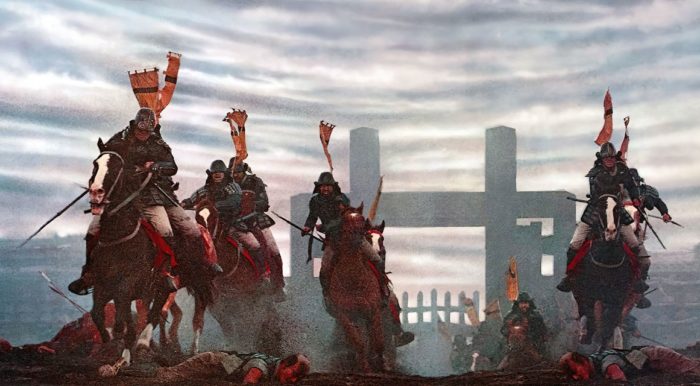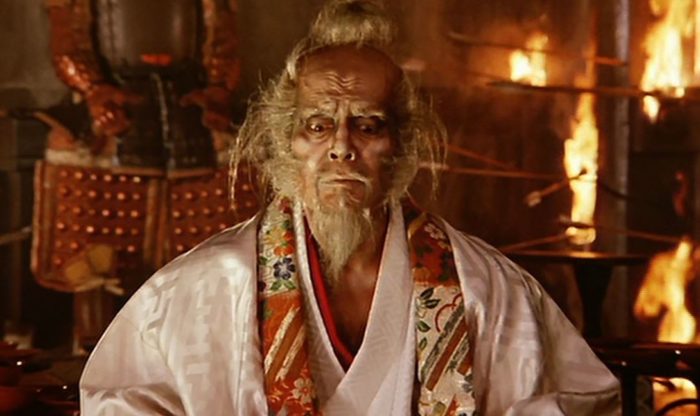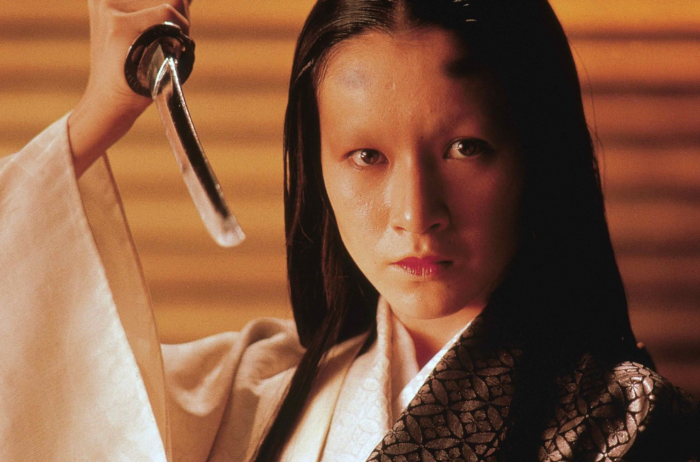
Every year I have to do at least one post that feels like homework. Not because the movie itself isn’t fun or entertaining but because of how much its production and story entails. Ran is an epic period-piece inspired by Shakespeare’s King Lear and the life of famous Daimyo (feudal lord) Moro Motonari. At 11 Million, Ran was the most expensive movie ever produced in Japan at that point in time. Hundreds of costumes and sets of armor were made, castles built, horses were everywhere. It’s staggering how much went into this movie. Which is probably why this movie feels staggering to write about, but I’ll try.
Ran–Which I’m just learning is pronounced “Ron” like Tron and means “Chaos”–is the story of an insane-looking old man, Lord Hidetora Ichimonji (Tatsuya Nakadai – The Face of Another, Harakiri)– who retires and hands down his empire to his three shitty sons; Taro (Akira Terao), Jiro (Jinpachi Nezu), and Saburo (Daisuke Ryu). So like Succession or The Righteous Gemstones, this is another classic shitty, powerful dad with even shittier kids story.
Inspired by Shakespeare’s King Lear, to the point of every character acting as a counterpart to every character in the play, Ran is full of intense scenes of characters in close chambers bickering and fighting for who gets what and how much. Contrasted with these intimate moments are some of the most spectacular set pieces ever committed to celluloid. We’re talking about huge battles on horseback, sword fights, men storming castles with flaming arrows and muskets, and a lot of blood.
One of my favorite images in the entire film is when Lord Ichimonji is sitting on a throne, resigned to defeat, as flaming arrows from his son’s forces shoot the walls behind him. It’s not like anything I’ve ever seen. Enjoy a low res image below!
The dialogue-driven scenes, although compelling, tend to drag for me (the movie is 163 minutes long) but the movie redeems itself with its sprawling visuals and battles. One of my favorite thematic elements is how the sky in the film is blue and majestic at the beginning of the film and gray and dreary by the end. One of the reasons Ran looks so distinct is that every scene was storyboarded by Kurosawa as paintings he’d been working on since the mid-1970s.
Easily the most distinct aesthetic in the film is the look of Lord Ichimonji. Nakadai was about 52 years old when the film was being made but is done up to look about 20 years older. He looks like a cadaver with bug-like eyes and thick gray lines running down his face. In every scene, he’s either screaming or catatonic, and the fact that he didn’t win an Oscar (wasn’t even nominated) is a tragedy in itself. This film did nab a few Oscar nominations (and a win for costumes) but it deserved a lot more.
Ran was a difficult production for Kurosawa. Not only was Kurosawa losing his vision, he also lost his wife of 39 years, actress Yōko Yaguchi, to a stroke during the production of the film. Deciding to work through the pain, Kurosawa only halted the set for one day before he continued filming.
By all logic, Ran should be a mess. An ailing auteur, a staggering production with hundreds of extras and costumes and horses. Yet, Ran is among Kurosawa’s finest. A brutal yet honest depiction of how greed tears apart families. My only regret is that I watched it on my laptop eating carrot sticks. This is a film that deserves better than that. This is a film that deserves your attention. Homework it may be. But sometimes homework can be fun.



